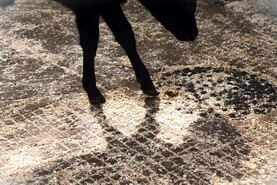During a recent Teagasc / Animal Health Ireland CalfCare webinar, the subject of calf jackets was discussed.
Vet and assistant professor in UCD school of veterinary medicine Catherine McAloon said that there can be a role for calf jackets, especially for young weak calves.
It is important to note that a calf jacket should never be put on a wet calf, as it will prevent the calf from drying.
Where a newborn calf is in need of extra heat, McAloon suggested that placing them under an infrared heat lamb or a hot-box is the best option.
Temperature control
While the ideal temperature in the calf-rearing shed is 15°C, this is highly unlikely during early spring when calving is at its peak.
For every degree below 15°C that the shed is, the calf will have to divert more energy from growth to maintaining a constant temperature.
This temperature differential can be overcome through good, draught-free housing and a deep, dry bed of straw for the calf to lie in.
Where a calf is suspected to be off form, a calf jacket can be a good aid in helping it to maintain its core temperature.
McAloon suggested that where jackets are used, calves should be fit to have them removed by three to four weeks of age when they are better able to regulate their own temperature.
Remember to adjust the calf jacket a number of times over the duration of the wear, as the calf will grow considerably over the first three weeks of life.
Rearing farms
While most calves on calf-to-beef farms are not moving until the calf is between two and three weeks of age, there is probably less need for calf jackets to be used.
However, having a couple in reserve for sick calves may be a good idea, especially during a cold spell of weather.
Clean jackets
Jackets should be cleaned between each use, so make sure the type you purchase is washable.
The last thing you want to do is put a dirty jacket on a sick calf whose immune system is already challenged.
Read more in this week’s Irish Farmers Journal in our 12-page calf focus.






 This is a subscriber-only article
This is a subscriber-only article










SHARING OPTIONS: